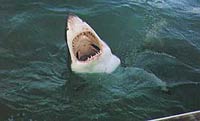What threatens the survival of Great White Sharks?
Commercial fishing
- Although not targeted, white sharks are caught as bycatch on longlines and in the nets of commercial fishers and in fish farm cages such as tuna farms. The estimated number of great white sharks caught by commercial and recreational fisheries is between 100–440 each year in Australia.
White shark products
- Traded products that come from white sharks include fins, jaws, teeth and meat (fresh, frozen or salted for human consumption), cartilage (used as a health food), and skin for leather . The liver is used to make oil used in medicines and the carcass can be used for fish-meal and fertilizer.
- The international shark fin trade increased a lot between 1980 and 1990, with demand increasing more during the 1990s. Prices for dried fin in Australia reached $275/kg, making it one of the most expensive fishery products. Jaws and teeth are the most valuable products and are available for up to US$425 per tooth and up to US$50,000 for a set of large jaws.
|

|
Beach netting
- T here are currently 49 meshed beaches between Newcastle and Wollongong in New South Wales. White sharks caught by beach meshing programs are usually small (less than 3 metres), and in many cases are smaller than 2 metres. Between 1950 and 2000, a total of 517 white sharks were captured in shark mesh nets in NSW. More than 670 white sharks have been caught in the Queensland Shark Control Program since 1962.
Are they protected?
The World Conservation Union considers the great white shark as ‘vulnerable to extinction’. White sharks are listed on at least 3 international conservation agreements and are fully protected in Australia, South Africa, Namibia, Maldives and Malta, and in California and Florida.
Alex Gaut ( MESA) adapted this information sheet for children (which is suitable for primary school students) from the information sheet compiled for the general public by from © Brad Norman (ECOCEAN) [info@whaleshark.org].
This information sheet may be copied for educational purposes. For any other purpose please contact your State MESA representative: http://www.mesa.edu.au/council/contacts.asp
|
International trade in white shark jaws and individual teeth are closely monitored as a result of listing on CITES.
(© Kate Rodda, PIRSA SARDI) |
